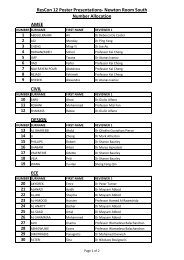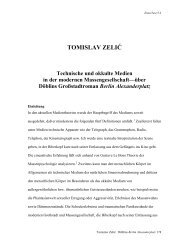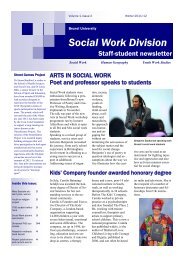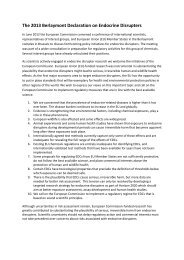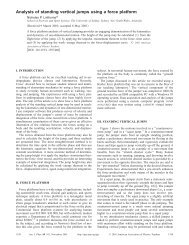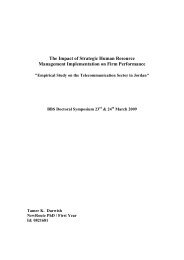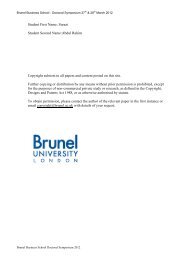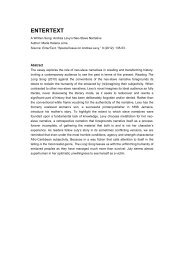Militarism, Misanthropy and the Body Politic: - Brunel University
Militarism, Misanthropy and the Body Politic: - Brunel University
Militarism, Misanthropy and the Body Politic: - Brunel University
Create successful ePaper yourself
Turn your PDF publications into a flip-book with our unique Google optimized e-Paper software.
EnterText 6.2<br />
<strong>and</strong> his fa<strong>the</strong>r, get out of Washington in time, but millions die, including <strong>the</strong> President’s<br />
wife. The party heads for Area 51, a government facility in Roswell, New Mexico, where<br />
alien materials previously recovered—a ship <strong>and</strong> several carcasses—are <strong>the</strong> subject of<br />
ongoing research. Captain Steven Hiller (Will Smith) brings along a new specimen, a<br />
badly injured alien pilot he has just shot down in a dogfight. Levinson discovers that <strong>the</strong><br />
military can implant a computer virus in <strong>the</strong> alien spacecraft, set off an explosion, disable<br />
<strong>the</strong> aliens’ shields, <strong>and</strong> bring down <strong>the</strong> mo<strong>the</strong>rship <strong>and</strong> its progeny. David <strong>and</strong> Steven set<br />
off to do so. Independence Day ends happily with fireworks ra<strong>the</strong>r than global<br />
annihilation.<br />
The most sustained analysis of <strong>the</strong> film, Michael Rogin’s Independence Day, or<br />
How I learned to Stop Worrying <strong>and</strong> Love <strong>the</strong> Enola Gay, serves as a starting point for<br />
this article. 4 This book catches <strong>the</strong> film’s extreme misanthropy by cataloguing <strong>the</strong> crude<br />
types that populate <strong>the</strong> film—<strong>the</strong> trash-talking, young African-American male, <strong>the</strong><br />
neuras<strong>the</strong>nic, fast-talking Jewish American, <strong>the</strong> flagrantly gay man, <strong>the</strong> oppressed,<br />
domesticated woman. Most critics responded positively to ID4’s stereotypes, judging<br />
perhaps that <strong>the</strong>se broad caricatures functioned like vaudevillian representations with <strong>the</strong><br />
power to amuse <strong>and</strong> to ameliorate difference. 5 Rogin shows, however, that <strong>the</strong>se<br />
representations function in ways similar to Stepin Fetchit <strong>and</strong> Amos <strong>and</strong> Andy,<br />
reinforcing <strong>the</strong> self-certainties of “mainstream” viewers at <strong>the</strong> expense of those who do<br />
not fit <strong>the</strong> mainstream’s restrictive definition. While Rogin points to <strong>the</strong>se<br />
representations, he does not consider how <strong>the</strong>y work. A careful look at <strong>the</strong> film reveals<br />
something canny <strong>and</strong> disturbing.<br />
Carol Vernallis: Independence Day 63




